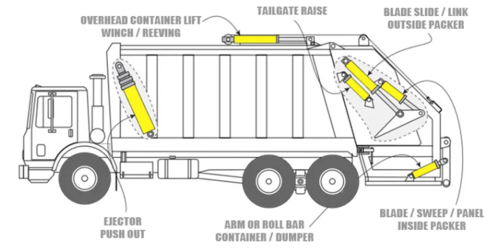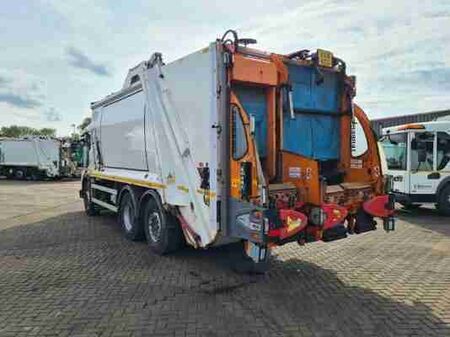Refuse Collection Vehicle
An RCV or Refuse Collection Vehicle is a type of lorry used to empty Wheelie Bins at a waste producers' premises without the removal of the Wheelie Bin from the site. The lorry works in a similar way to a REL Lorry but uses a 'comb' lifting device that hooks under the lip of Wheelie Bin (see Wheelie Bin WikiWaste page) to allow it be lifted and emptied into the rear of the lorry (hence it is also sometimes called a 'rear end loader'). An RCV can lift two smaller Wheelie Bins such as a 240 litre capacity, or one larger Wheelie Bin such as a 1100 litre capacity.

Summary
An RCV or Refuse Collection Vehicle is a type of lorry used to empty Wheelie Bins at a waste producers' premises without the removal of the Wheelie Bin from the site. The lorry works in a similar way to a REL Lorry but uses a 'comb' lifting device that hooks under the lip of Wheelie Bin (see Wheelie Bin WikiWaste page) to allow it be lifted and emptied into the rear of the lorry (hence it is also sometimes called a 'rear end loader'). An RCV can lift two smaller Wheelie Bins such as a 240 litre capacity, or one larger Wheelie Bin such as a 1100 litre capacity.
Process
The Wheelie Bin has a lip on the front edge opposite the hinge of the lid, which locates on a 'comb' lifting unit attached to the rear of the lorry. When the comb is engaged the bin is lifted and pivots on the rear of the lorry, and empties its contents into the rear of lorry. The point of waste deposit into the lorry is called a hopper, and within this unit there is a hydraulic ram that pushes the waste into the body of the lorry via a blade through a series of compacting cycles)(see diagram below). This compaction allows multiple bins of compressible waste (such as Cardboard and/or Residual Waste) to be emptied and compacted into the lorry to optimise the weight and the logistics associated with onward transportation for processing. At the point of unloading, the rear section of the lorry, including the compacting hopper unit, opens upwards at the rear of the lorry, and a separate hydraulic ram is then used to push the collected waste out of the vehicle.

Other Configurations
The body of an RCV can be configured to collect multiple materials, something which has become more common since the early 2000's. This might include, for example, a split body to facilitate a Twin Stream Collection and/or an additional separate non-compacting section for food waste at the front of the lorry (often known as a 'pod') with its own lifting device on the side of the RCV as shown in the pictures below:
 |
 |
| Example of Split Body RCV for Twin Stream Collection | Example of 'pod' on front of on RCV for Food Waste Collection |
